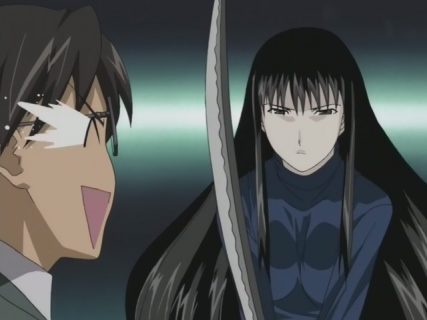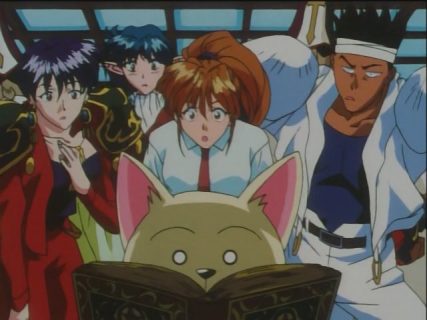Akamatsu-sensei Worried About Foreign Regulation
A lot of stuff happened while I was on my road trip. I did notice that Amazon had started banning some manga and light novel titles because they no longer met Amazon’s unclear standards. And in this vein, I more recently became aware of Steam banning a PG English port of a Japanese ero visual novel. I’ll write about that later.
While reading up on this, I discovered that right when I started my vacation in June, Akamatsu-sensei (Love Hina, Negima!, UQ Holder) expressed concerns about foreign countries regulating anime and manga.
What Did Akamatsu-sensei Say
At the end of June, Akamatsu-sensei went to speak to the House of Councilors, which is the legislative upper house of the National DIET of Japan. And he reported back on what was discussed on Twitter.
Crunchyroll translated the first Tweet as follows:
This month, I was invited to participate in a House of Councilors witness questioning session, but instead, a member of the DIET [Japanese government] asked me, ‘What measures are needed for Japanese manga need to survive in the world?’ I replied, ‘First and foremost, freedom of expression. Compared to other countries, Japan’s forte is its freedom of creativity. However, with foreign platforms becoming more and more dominant, I would like to avoid a situation where Japanese works are regulated by foreign standards.’
Google Translate provided this as the translation of the second Tweet.
→ I want to avoid situations where Japanese works are regulated by overseas standards. “. Also, “At the National Manga Center, which was sent off this time, raw manuscripts are stored, displayed, and monetized to prevent them from leaking overseas.” The teachers of the members of the Diet were also very nodding.
Basically, Sensei wants the government to create a National Manga Center to store and exhibit manga works, to include the rough drafts and raw manuscripts. And the members of the DIET agreed with him.
“Japan Must Change”
When I lived in Japan, an anime like Ranma 1/2 was shown in the late afternoon, topless nudity not withstanding. Shounen manga titles could have the same thing. (An example of this would be the first volume or two of Inuyasha). And I admit, as a Westerner, it was shocking to me. I remember hearing about Western pressure on Japan to stop this kind of thing back then.
So today, TV releases of anime are edited/censored to not have nudity or the like. In manga magazines, content may also be censored. However this content is provided in the DVD/BD release for anime, or the tankoubon volume for manga. HOWEVER, when American distributors license said products for Western audiences, they often feel compelled to change things for said audience.
It isn’t just some Christian conservative puritan push either. Back when I lived in Japan, that was probably more the case. And there are still some outlying politicians on the right who’d advocate this. (I may do a post on this in the future.) But the cancel culture that’s on Twitter and other social media platforms isn’t coming from the right.
And in the case of anime and manga, someone (whom I will not name so as not to make it personal, but who’s politically VERY leftist) from Viz stated earlier this year that conversations between Japanese publishers and Western distributors would happen. Why? Japan needs to change its anime and manga (and subsequently, game) content to meet Western “standards”. No wonder Akamatsu-sensei is concerned.
My Thoughts
There’s a lot of NASTY stuff that comes out of Japan. I think folks who create this stuff or enjoy this stuff may not be all there in the head. Nevertheless, because it is in a game, manga, or anime, my thought is, “To each their own. No actual people are being harmed here, so its none of my business.”
And in my own experiences, I’ve admitted to being VERY uncomfortable with the Fate/kaleid liner PRISMA☆ILLYA series. The ecchi content there is something I really don’t like, although the story (and some of the humor) are pretty good. And yeah, I wish the ecchi content wasn’t there so I could then buy the series. After all, it doesn’t need to be ecchi at all to accommodate story needs.
However, I would never tell the Japanese they MUST change to make me feel more comfortable. And I would never look down on folks who have no problem with the ecchi content that makes me feel unclean. Had the series actually crossed the hentai line, I would have stopped watching for sure. As it is, I vote with my wallet and just don’t buy a physical copy of the title.
But alas, there are folks on both sides of the political isle who feel the need to interfere and regulate things in Japan. As such, I’m already opposed to Western distributors banning or censoring things so as not to run afoul of a Twitter mob. But I’m even MORE opposed to the notion of literary colonization of Japan to force them to adapt to Western ways in manga, anime, and games.



 August 16th, 2020
August 16th, 2020  AstroNerdBoy
AstroNerdBoy 


 Posted in
Posted in  Tags:
Tags: 
I agree with you. I’m not American, though, so “American” values of propriety can take a hike. Topless nudity manga are available here with a 16+ restriction (e.g Futari Ecchi). I’m not opposed to most things that manga/anime portray, the only content in media I outright avoid is really hardcore stuff.
If I were Japan I’d tell American companies to take it or leave it. Why should MY art submit to YOUR standards. There’s always someone else willing to buy the rights. SJWs should just fuck off. Nobody likes them. They’re doing their shit just for pure self-satisfaction – “Oh, look. I’ve did something good for society today.” Blergh.
I have no idea why people get upset over drawings and want to assign ‘human rights’ to fictional beings. People criticizing art is fine and dandy, but to just curse it for simply existing? Is this how the Impressionists have felt way back then?
I’ll stop here. If I go on I’ll just write myself into a rage.
Hope you’re well, Astro. See ya.
I need to do a follow up post. I guess this “ban anime/manga/J-games” attitude is also in Australia and maybe New Zealand as well. And then there’s bloody China, who wants to change the world to their Communist ways.
Yeah, that’s a head scratcher. No matter how vile, at the end of the day, nobody was actually harmed. Kinda like when they make a movie and CGI animals die, there has to be a disclaimer to say, “No actual animals were harmed”.
I totally agree that censorship is really a bad idea. Real issues are dealt with in manga and to a lesser extent in anime as well as escapist stories. Censorship adds value to the censored materials and will result in circumvention of such attempts. The same effect was seen in the War On Drugs where dealing drugs became a short route to a high income.
Does Amazon have any stated standards?
Fanfox is publishing “Rapeman” and censoring “Seitokai Yakuindomo”. I have reproached them on this account but they have several other stories that make light of rape of women and of men. Some are clearly (at least to me) attempts at “grooming” of children to accept
the advance of stronger elders.
Freedom of expression even when I disapprove of such expression is much better than
censorship. Like the proverbial camel coming into the tent after its nose enters the Censors
are happy to extend their coverage from sexual matters to political matters such as the
present administration.
bliss
Absolutely!
This might have just been intended* as a “Tee hee silly barbarians” story since it was in Reader’s Digest decades ago, so I really can’t vouch for its accuracy – but it seems to fit in with other known facts. The gist of it was: When the US occupied Japan following WW2, some general / governor / whatever was shocked to see public baths with men and women together. He ordered them to immediately separate men and women. The confused bathhouse owners complied… by stretching a rope across, and each gender had to stay on their side of the rope.
Sometimes I really wonder about the wisdom of the extremes to which the US fetishizes nudity, and whether it’s perversely contributed to rape culture. But setting that aside, I really think the outrage brigades of the US (both sides) need to remove a lot of 2x4s out of their own eyes, before they start crusades to pull splinters out of others’.
* – Instead it got me wondering, even back then, about imposing our mores on others who seem to have been doing fine without them.
I think segregated bathing for sento was introduced during the Meiji period (1907). And as I learned recently, this is also when showing pubic hair and genitals was considered obscene (Article 175 of the Criminal Code). Since the Meiji period is when Japan was made more Western, I think the law was introduced to adopt a more Western thoughts on the subject of nudity and thus be a more civilized nation.
So there was Western influence there for sure. And there has been pressure on Japan to change things in more modern times. Some of it I can’t argue against, since real people were depicted. But when it shifts to things were no actual people are shown, then I have a problem with it.
The measures against public nudity and mixed bathing were adopted to give the West the idea that the Japanese were adopting “civilized” standards. This also led to the banning of
the many phallic monuments on public display. If you want a clear view of Japan in this transitional period look up Isabella Bird, a British lady who traveled before the modernization
took full effect. Here is the note I made:
Unbeaten Tracks in Japan by Isabella Bird SFPL 915.2
Travels the length of Japan in 1878 including the island
of Hokkaido then called Yezo. Amazing traveler putting
up with very difficult conditions in a pre-modern setting.
Lots of use as reference to the conditions in Meji, Japan
10 years or so into the reforms with much of the old Japan
being observed and reported in detail, travels among the
Ainu of Yezo.
A lot of things were done just for the purpose of impressing
Westerners with the civility of the Japanese, Lots of other
books including about the adoption of the Western Calendar.
bliss
Yeah, that’s true
I can definitely see it going either way:
* Readers Digest, at least back then, loved featuring jokes and stories with “silly barbarian” stereotypes – even if they had to manufacture them.
* But it might have had some basis in reality, considering that even today there are still some mixed baths (i.e. Mr. Important might have stumbled across one and become Righteously Outraged about it, then the story grew a little every time it was retold).
I know lots of people subscribe to the new Red and Blue religions, but my religion is Reformed Latter-Day Nunyaism. If it’s not harming a real person, but you’re Righteously Outraged because it’s Just Wrong according to your Blue or Red Gospel… that doesn’t change the fact it’s Nunya Dambidness. (^_~)
(Yes, you too over there in the corner who’s just heartbroken over it. Especially you.)
I’m not sure about sento baths. Those seem to be pretty segregated. Onsen baths, on the other hand, do have the mixed bathing you describe.